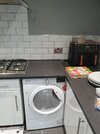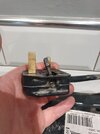Too things, one is a vented tumble drier takes a lot of current, so all connections need to be sound, once a plug has over heated in a socket like the one you show, it can damage the spring pressure in the socket, so unless socket is changed, replacement plug will also fail as poor connection on the pins.
Second is with a heat pump tumble drier the volt drop is important, most instructions state do not use extension leads because of the volt drop problem not only in the cable, but in the use of multi 13 amp fuses.
I am aware of this problem, so when fitting my tumble drier I was 2.5 mm² cable for the extension lead, and a good beefy plug on the extension lead better suited to dissipate any heat. Yes would have been better to have extended the ring final, but units had already been fitted to the wall, so that would have been a huge job. I am aware that plugs should be in free air, so the heat from the fuse can be dissipated, but having moved from a vented to heat pump type, the current involved has dropped.
With the vented we found on 2 kW it would take 60 minutes, and on 1 kW it would take 90 minutes approx, so it uses less power on the lower setting, moving to heat pump type power dropped to 500 watt and still dries in 90 minutes, so around half the cost to dry, and fitted above washer so using same soil pipe drain as washing machine, however not the same power outlet.
At some point want to fit the energy meter and see what it uses, on my to do list.



